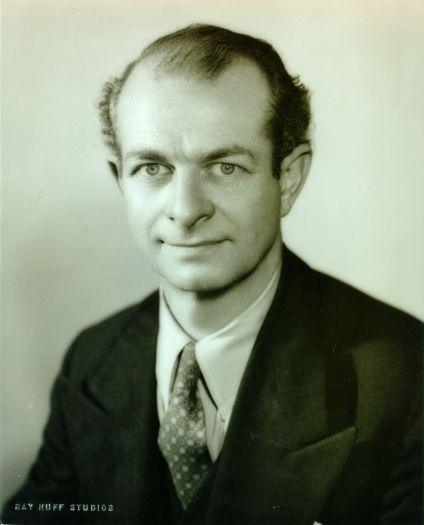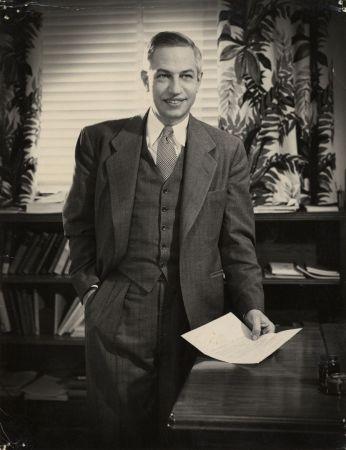 Linus Pauling, 1946
Linus Pauling, 1946[Pauling as Administrator]
As the government’s demand for research and development projects began to wane following the end of the Second World War, the Division of Chemistry and Chemical Engineering at the California Institute of Technology began a period of reorganization. One early change was a shift in policy for graduate studies wherein only those able to attend full time were admitted. The division also instituted a requirement that graduate students from the Biology division working under someone in Chemistry receive permission from their Biology adviser first.
But amidst these and other changes, one very important continuation remained: the division’s involvement with military research. One such activity that ultimately involved Linus Pauling was led by two division members from the Chemical Engineering group, B. H. Sage and Dean Lacey, who had assumed a post-war contract from the Bureau of Ordnance on improving double-base propellant processing. This classified work to develop “smokeless powder” was less pure chemistry and more straight up engineering. As such, the contract was in potential conflict with the division’s policy on accepting funding that restricted publication.
Noting this, Sage went to Pauling for his approval. And as the division chair, Pauling judged the research to be worthy of an exception, telling Sage, “I do not see how you can avoid doing work of this sort; it seems to me to be clearly your duty, in view of your experience.”
Typical of the administrator’s burden, Pauling swiftly turned his attention to mediating a dispute between Sage and J. Holmes Sturdivant over shared responsibilities at the Chemistry Shop. The problem came to Pauling’s attention in November 1946 when Sturdivant informed Pauling that the Chemical Engineering group had “contributed essentially nothing toward the maintenance of the Chemistry Shop facilities” despite spending 10% to 17% of their time using the shop. Sturdivant subsequently requested that Pauling require Chemical Engineering to contribute at least 5% of their time over the course of a year towards maintenance. To make up for past indiscretions, Sturdivant also suggested that the engineers allocate 100 hours to shop maintenance over the next month.
Sage, speaking on behalf of the Chemical Engineering group, expressed annoyance with Sturdivant’s requests, and claimed that the engineers had in fact done routine maintenance and housekeeping, while also taking “complete responsibility for the maintenance of the small so-called Chemical Engineering Shop.” (Pauling, apparently puzzled by Sage’s reference to a Chemical Engineering Shop, underlined this line of text with a question mark next to it.) Sage also pointed out that the extra amount of time that Sturdivant wanted the engineers to spend on maintenance would accrue to an additional 17% of their time spent in the shop. Sage concluded with a request that the group receive $50 a month more to help cover shop-related overhead costs paid to the division, something that they had not been asked to pay in the past.
In response, Sturdivant told Pauling and Sage that the increase in overhead charges had to do with changes made during the war as research shifted to other areas. Specifically, the Committee on Institute Shops had recommended that all campus shops charge overhead to the groups that used them. Sturdivant, seeking to appease Sage on some level, then recommended lowering the Chemical Engineering group’s overhead charge to $20 per month for the next 18 months. Pauling agreed that this was a reasonable compromise and the dispute was settled.
Anticipating future disputes of this sort, Pauling inquired with upper administration about the possibility of devoting new space on campus to chemical engineering. As it turned out, nothing major was to happen for another decade — not until 1956 did Caltech break ground for a new building dedicated to the division’s engineers.
 Lee DuBridge, 1948
Lee DuBridge, 1948As a member of the Institute’s Executive Committee, Pauling was well-positioned to work with the incoming Lee A. DuBridge, the first person to officially hold the title of President of Caltech. Before starting in Pasadena, DuBridge had spent six years as the first director of the radiation laboratory at the Massachusetts Institute of Technology. And though he officially became Caltech’s president in the fall of 1946, he began working with Pauling before then to begin implementing his vision for the Institute.
DuBridge and Pauling shared a similar point of view on faculty pay: to recruit and retain the best, the Institute had to offer high salaries. With this idea in mind, they first worked together to hire John G. Kirkwood as Professor of Chemistry, meeting in Washington, D.C., (DuBridge hadn’t yet moved to California) in April 1946 to discuss the best way to attract him. At the end of their meeting, they decided that $10,000 per year would do it.
Once Pauling was back in Pasadena, he wrote to DuBridge that the Executive Committee thought the amount was too high, as only a “few people” – including Pauling – made that much at the Institute. DuBridge was disappointed by this news, writing that
My first reaction is to say a salary of this amount has got to come as a fairly common figure in the near future if we are to get and keep good men – and therefore lets go ahead in this case.
Thus emboldened, Pauling reached out to Kirkwood, who replied that he would need to think about the offer. DuBridge had not expected this response and was also a bit perturbed at Pauling, since he had meant for Pauling to merely inquire with Kirkwood about his potential interest at that salary level. In the end, Kirkwood accepted the position, but only remained at Caltech until 1951, leaving to take up the Sterling Professorship at Yale.
Membership on the Executive Committee also obligated Pauling to spend time filling positions outside of his own division. While at Cornell, John Kirkwood had worked closely with physicist Hans A. Bethe, whom Pauling had tried to persuade to come to Caltech to replace Robert Oppenheimer in 1946. The previous fall, Caltech had offered Oppenheimer $10,000 to return to Pasadena now that his war-time service at the Los Alamos Laboratory had concluded. Not long after, the Institute tried to sweeten the deal by offering him the chairmanship of the Division of Physics, Mathematics, and Electrical Engineering.
These offers were not enough to convince Oppenheimer to stay, and he ended up as Director of the Institute for Advanced Study in Princeton. Bethe was likewise not convinced that Pasadena would make for a good fit and suggested that Pauling make an inquiry with Robert F. Christy, who had worked with Oppenheimer at Los Alamos and had been involved with the Manhattan Project at the University of Chicago as well. Pauling heeded this advice and Christy went on to spend the rest of his career at Caltech.
Bringing in new faculty members and keeping the peace between current employees consistently occupied Pauling’s time as a division chair. The imperative to reorganize research objectives following the end of World War II only made those tasks more urgent and weighty.
